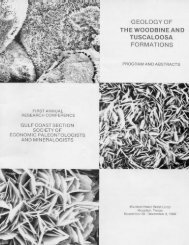Petroleum Systems of Deep-Water Basins - Gulf Coast Section SEPM
Petroleum Systems of Deep-Water Basins - Gulf Coast Section SEPM
Petroleum Systems of Deep-Water Basins - Gulf Coast Section SEPM
Create successful ePaper yourself
Turn your PDF publications into a flip-book with our unique Google optimized e-Paper software.
Complex <strong>Petroleum</strong> <strong>Systems</strong> Developed<br />
by Subduction Process, Offshore Talara Basin,<br />
Northwest Peru<br />
Fernando Zúñiga-Rivero<br />
Hugh Hay-Roe<br />
BPZ & Associates, Inc.<br />
11999 Katy Freeway, Suite 560<br />
Houston, Texas 77079<br />
(e-mail: bpz@bpzenergy.com)<br />
Linda Jenkins<br />
10 McCarty Island Road<br />
Picayune, Mississippi 39466<br />
(e-mail: libertybelle55@hotmail.com)<br />
Allen Lowrie<br />
238 FZ Goss Road<br />
Picayune, Mississippi 39466-9458<br />
(e-mail: alowrie@webtv.com)<br />
Abstract<br />
Study <strong>of</strong> 2-D marine seismic data <strong>of</strong> 1993 vintage along the Peruvian coast has led to the idea that subduction <strong>of</strong><br />
marine sediments beneath a continental plate may be a potentially important mechanism for petroleum generation.<br />
The concept can be embodied in a new geologic model involving five essential factors:<br />
1. Subduction <strong>of</strong> both continental and oceanic sediments along the Peru Trench.<br />
2. Incorporation into the subducted material <strong>of</strong> rich organic material from two different sources:<br />
3. From the west: subducted deep-ocean sediments.<br />
4. From above: organic matter precipitated from the surficial Humboldt Current.<br />
5. Probable duration <strong>of</strong> this previously unexamined mechanism during the past 100 million years.<br />
6. Upward migration <strong>of</strong> the thermally mature, buoyant hydrocarbon fluids (first as liquid petroleum, later as natural<br />
gas) through the shattered sediments and along normal faults cutting the slope margin.<br />
7. Entrapment <strong>of</strong> rising hydrocarbons in anticlinal closures, normal fault-blocks and fluviodeltaic stratigraphic traps.<br />
Hydrocarbon formation must have benefited from unique oceanographic-geologic conditions associated with the<br />
“El Niño” phenomenon, and probably effective for the past 20-25 Ma. El Niño periodically generates a massive erosion<br />
<strong>of</strong> the coastal plain, which provides reservoir-grade sediments to the continental slope. Normal organic output<br />
from the nutrient-rich Humboldt Current is a primary factor in the creation <strong>of</strong> source rocks; the other source is subducted<br />
deep-sea sediments. Shallow cores taken during Leg 112 <strong>of</strong> DSDP (Yeats et al, 1976) indicate total organic<br />
carbon (TOC) ranging from 0.5% to 2.0%. Hydrocarbon generation could take place after incorporation into the subduction<br />
zone. Subsidence and burial <strong>of</strong> Tertiary, Mesozoic, and Paleozoic sediments would also provide hydrocarbon<br />
sources, whether derived from the paleo-shelf or the paleo-slope. The presence <strong>of</strong> two separate hydrocarbon-generating<br />
systems would enhance the prospectiveness <strong>of</strong> the Peruvian continental margin. The logical place to commence<br />
exploration is westward from the prolific and long-developed onshore and shallow <strong>of</strong>fshore sectors <strong>of</strong> the Talara<br />
Basin.<br />
53

















